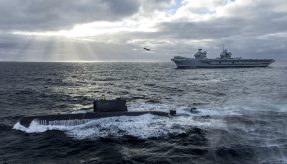
Northrop Grumman’s autonomous high-altitude, long-endurance (HALE) Broad Area Maritime Surveillance-Demonstrator (BAMS-D) system has recently surpassed 40,000 flight hours during a routine mission in the US Central Command (USCENTCOM) area of operations.
“This milestone in the BAMS-D program demonstrates Northrop Grumman’s commitment to delivering critical capabilities to our customers that provide an advantage to US and coalition partners in theatre,” said Doug Shaffer, vice president and program manager, Triton programs, Northrop Grumman. “BAMS-D providing operational support well beyond its intended demonstration period highlights the unrivaled strategic value of autonomous maritime HALE while the Navy integrates the MQ-4C Triton into its vital maritime patrol mission.”
BAMS-D entered operational service for the U.S. Navy in 2009. Originally intended to be a six-month demonstration deployment, BAMS-D has supported U.S. Navy intelligence, surveillance and reconnaissance (ISR) missions in USCENTCOM for more than 12 years.
“BAMS-D sustainment is truly a Northrop Grumman cross-enterprise effort, and is a testament to our unwavering commitment to mission readiness,” continued Shaffer.
Capt. James P. Johnston, Commander, Task Force 57, said: “This is a significant milestone for any aircraft, but especially remarkable for an originally planned 6-month demonstration system.
“The persistence and dependability of the BAMS-D system and the resilience of the personnel who operate the platform here in 5th Fleet, are essential in sustaining maritime security and freedom of navigation throughout the region.”
While BAMS-D remains in operational service, its replacement, the MQ-4C Triton, completed its first year of an early operating capability deployment in the U.S. Indo-Pacific area of responsibility. The Triton system is currently progressing toward a multi-intelligence configuration and will ultimately support five operational orbits for the Navy with 68 operational aircraft. Australia is set to receive their first Triton in 2023 as part of a cooperative development program that will enable intelligence sharing between the U.S. and Australia.
Northrop Grumman’s family of autonomous high-altitude, long-endurance systems perform critical wide-area ISR collection. Today, autonomous HALE systems operate across the globe, with 24+ hour endurance, collecting essential ISR data over land and sea to enable rapid, informed decision-making. In the future, these systems will connect the joint force, implementing advanced autonomy and AI/ML while delivering indispensable capabilities with fewer people to provide information at the speed of relevance.
image courtesy of Northrop Grumman
If you would like to join our community and read more articles like this then please click here







